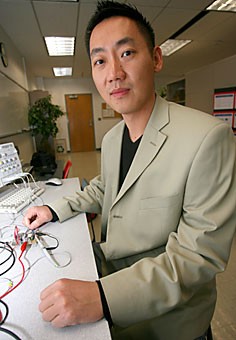Video may have killed the radio star, but radio isn’t going down without a fight. Radio’s next move: high definition.
A low-cost microchip that will offer portable high-definition radio is being developed at the UA by Dongsheng Ma, an assistant professor of electrical and computer engineering, and Inshad Chowdhury, a graduate student in electrical and computer engineering.
They are working on the project in conjunction with Texas Instruments teams based in Tucson, Dallas and Oregon.
Current high-definition radio technology requires too much power and the units are too large to be portable. The high definition receivers offered today are tabletop models or installed after-market in cars, said C.R. Teeple, marketing manager for Texas Instruments in Tucson.
The UA researchers aim to fit the technology on a single microchip, which will allow it to be used in portable devices, Teeple said.
Texas Instruments plans on having the technology available to consumers by next year.
High-definition radio offers better quality sound than traditional radio broadcasting. FM channels offer CD-quality sound.
“”One reason that radio is not popular is you want to have high quality,”” Ma said. “”High-definition radio will give you this kind of quality.””
High-definition radios also offer the listener the option of viewing additional information about the artist they are listening to, such as a biography, past albums and other relevant facts, Ma said.
Unlike satellite radio, high-definition radio listeners will not need a subscription in order to listen to programming. Radio stations that have the capability will broadcast in high definition, and anyone with a receiver can tune in.
“”The cost will be much, much cheaper than satellite radio, “” Ma said. “”As long as you have a receiver you can listen to the music and all the programs.””
The cost of upgrading a radio station so it is able to broadcast in high definition is around $50,000, Ma said.
Today’s high-definition radio receivers cost $100 to $150, and the smaller version is projected to be within the same price range.
“”Our intention is to drive the cost down in general,”” Teeple said. “”The project (the UA) is working on with us is one of the important steps in getting the cost down.””
Digital high-definition radio also has the option of dividing a single frequency into two different programs. Using this technology, radio stations can broadcast two different music channels using their frequency.
“”It’s what we call multicasting,”” said Tim Richards, regional vice president of programming for Clear Channel Communications in Tucson. “”With the bandwidth of HD you can broadcast multiple stations on one frequency.””
Listeners can pick the music program they want to listen to from the multicast.
“”Basically, what it does is allow more niche broadcasting,”” Teeple said. “”You get more variety in the market.””
There are approximately 1,200 radio stations broadcasting in high definition in the United States. In Tucson, there are nine FM stations utilizing high-definition broadcasting, Teeple said.
Of Tucson’s nine high-definition FM stations, four Clear Channel Communications-owned radio stations are already using multicasting to broadcast different music genres in the same frequency.
Tucson FM station 98.3 KOHT broadcasts Top-40 R&B programming on one channel and old-school hip-hop and R&B on its other channel, and 93.7 KRQ broadcasts Top-40 hits on one channel and contemporary country music on its other channel.
There is no data on the number of listeners who tune in to secondary broadcasts of a frequency, Richards said.
“”We’ve been working in this area for a few years,”” Teeple said. “”There’s a lot of background and work involved in getting up to this point and (the UA) is helping us take it to the next step. This is taking commercial, terrestrial radio into the digital age.””









